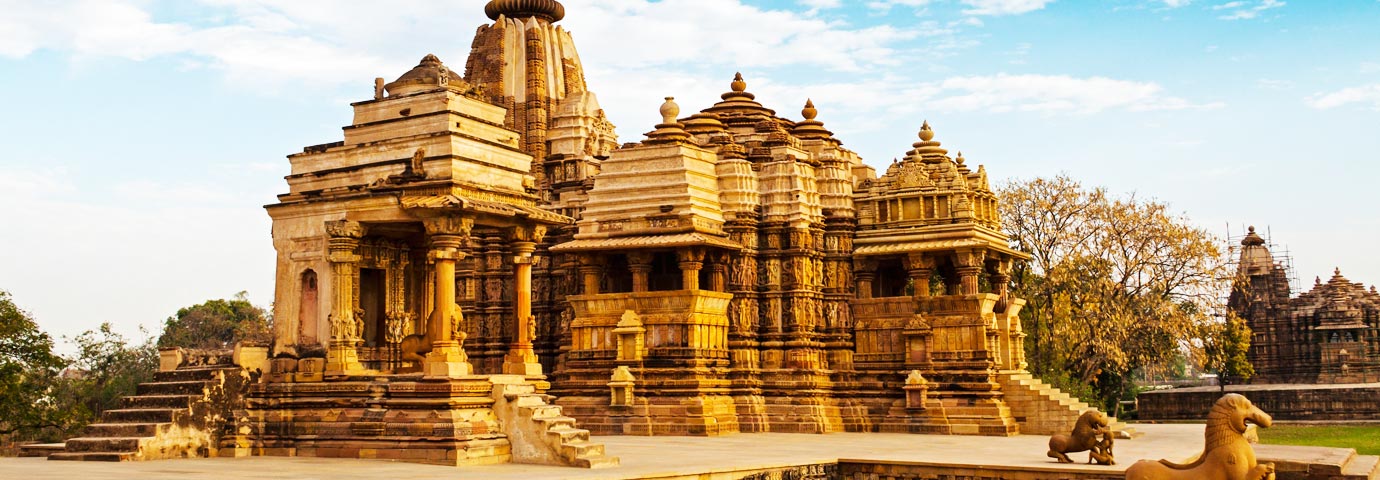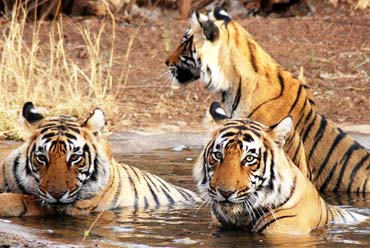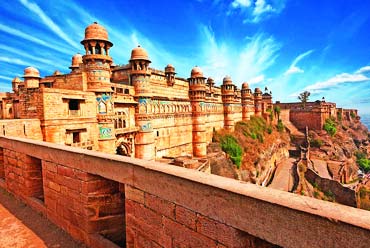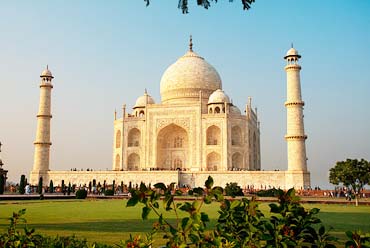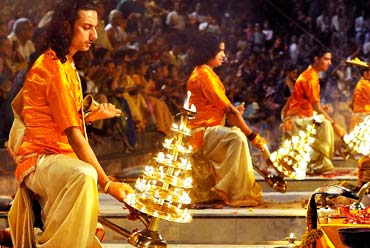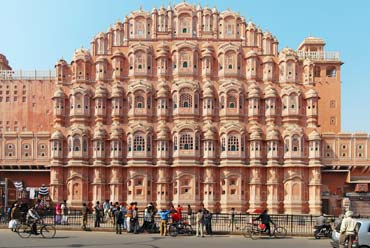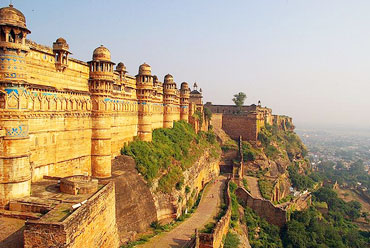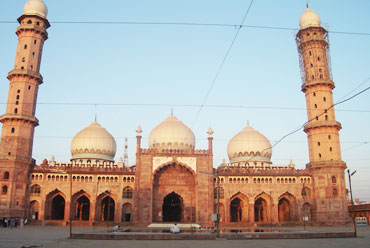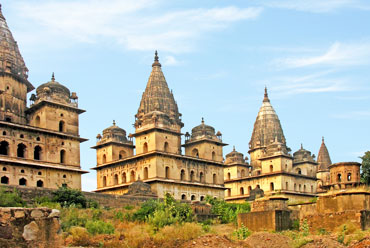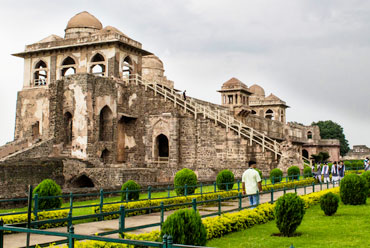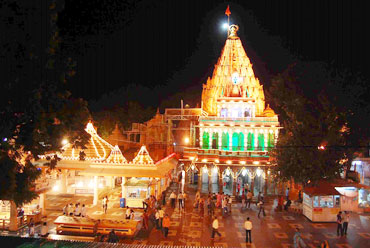Tourist Attractions in Khajuraho
Architecturally, the temples of Khajuraho India reveal the art of Khajuraho, they followed a three- or five-part floor plan. The larger temples have an ardhamandapa (porch), then a mandapa (hall) leading to a mahamandapa (main hall) from where an aunterale (vestibule) led into the Garbha Griha (sanctum) containing the devta (god) or devi (goddess). An enclosed pradakshinapathar (corridor or verandah) runs around this sanctum.
In the smaller temples, the second and the last feature were omitted. Each component of the temple was topped by pyramid-shaped towers leading in ascending order like a series of mountain peaks to the soaring shikhara (tower).
The ornate vertical elements are balanced by horizontal bands of sculpture running round the temple; superb in execution and seeming to grow out of the temple itself, they merge beautifully with the overall design.
Western Group of Temples
The Kandariya Mahadeo is considered the most evolved example of central Indian temple architecture. Dedicated to Lord Shiva, this temple is also the largest of Khajuraho's temples.
The Lakshmana Temple is one of the oldest and finest of the western group of temples. The temple is rather big with four other shrines attached to it. Although the general norm in other temples is three bands of sculpture, this temple has only two. Recurrent themes are battles, hunting, and women.
The temple of Devi Jagdamba is considered by many to be one of the most erotic temples of Khajuraho. The temple houses Khajuraho's most talked-about image, mithuna, and the sensuously carved figures. It is not clear until today as to which deity this temple is dedicated.
The temple of Vishvanath and Nandi celebrates the marriage of Lord Shiva with Parvati. The way women have been depicted in this temple draw the most attention. From traditional images of women fondling babies and writing letters, they are seen also as the most provocative of images.
Chaunsat Yogini is the oldest of the surviving temples of Khajuraho India. This temple is dedicated to goddesses Kali. This is the only temple in Khajuraho India that is built in granite. The name chaunsat (sixty-four) comes from the cells of 64 attendants of Goddess Kali. Goddess Kali herself was the 65th one.
Other important temples in the western group are the temples of Lakshmi and Varaha, Mahadev, Chitragupta, Parvati, and Matangesvara.
Eastern Group of Temples
The temple of Parsvanath is the largest of the Jain temples in Khajuraho India and the finest. The temple was originally dedicated to Adinath and latter to Parsvanath. It is the finest example of the sensitive art without any sexual motifs. Near this temple is the temple of Adinath with fine carvings. The temple is quite similar to the Hindu temples of Khajuraho.
Shantinath is the youngest of all the temples in Khajuraho India. Though it looks like the most other temples in Khajuraho, it is just a century old. The temple has a four and a half meter statue of Adinath.
Mostly in ruins now, the temple of Ghantai has fine columns and chains and bells, with a figure of a Jain goddess on a garuda.
One of the oldest temples in Khajuraho is the temple of Brahma and Hanuman. The temple is built mostly of granite and sandstone. Actually, this temple is dedicated to Lord Vishnu. Nearby is a Hanuman temple reputed to have the earliest inscription dating back to AD 922 on a 2½ -m statue.
Two other notable temples are Javari and Vamana temple.
The Southern Group
There are only two temples in the southern group of temples. The Duladeo is somewhat new and built in a time when the creativity of Khajuraho was well down its peak. The temple has wooden structures that take away its authenticity somewhat.
The other temple is of Chaturbhuja, pretty far from the village. The temple has a 3-m-high statue of Vishnu.
Apart from the temples, another place that can be visited here is the Archeological Museum. It has a very good collection of sculpture, inscriptions, and architectural objects.
Places Around Khajuraho India
Dhubela Museum is 64 km away from Khajuraho. Located on the bank of a lake, the museum houses a wide variety of sculpture of the Shakti cult. There are different sections on garments, weapons, and paintings.
Benisagar Lake is a tourist spot around 7 km away from Khajuraho. There is a dam on Khudar River and is an ideal place for boating and angling.
Panna is a historical city and was the capital of Bundela kingdom. Panna has one of the most famous diamond mines of the world and is around 56 km from Khajuraho. There is also the Panna National Park, spread over 546 km and situated on the banks of Ken river. This is an ideal place for wildlife watchers.
On the Ken River is Pandava Waterfall, 30 km from Khajuraho. It is believed that the Pandavas spent a good part of their exile here. Another waterfall, the Ranch, is situated at a distance of 25 km from the Pandava Waterfall.
Ranguan Lake is 20 km from Khajuraho. This is a site at the confluence of Ken and Simri rivers.
At the foot of Maniyagarh hills is Rajgarh Palace. This palace is around 50 years old and 25 km away from Khajuraho.
At a distance of 80 km is the Ajaygarh Fort, once the capital of Chandelas in their declining years. It is built at a height of 688 m. Another fort is Kalinjar, located on the Vindhya Range at a distance of 100 km. It was built during Gupta period and captured by Shri Yashovarman, the Chandela king, in the 10th century.

